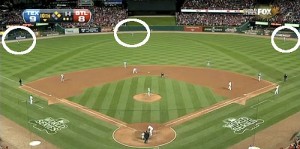Defensive Trade-Offs in Baseball
Baseball is filled with bits of conventional wisdom—don’t make the first out at third base; the second hitter must be able to handle the bat; pitchers must bat ninth, and countless others. Among these unwritten rules is the concept of the “no-doubles defense,” an idea designed to minimize the risk of allowing extra-base hits (i.e., doubles and triples).
The basic premise of the no-doubles defense is that the outfielders play far enough back (close enough to the outfield fences) that no batted ball can be hit over their heads—unless it goes over the fence, that is. This strategy is used almost exclusively in the late innings of close games, where preventing a runner from getting into scoring position (on second or third base) is crucial. If the ball doesn’t get by the outfielders to the wall, it is very difficult for the batter to reach scoring position. But with the outfielders playing back, a batted ball is more likely to fall in front of them for a hit. So at what point does the strategy begin to backfire, and the cost of allowing more singles begin to outweigh the gain from preventing doubles? That is, how far should the outfielder move back in order to maximize the expected benefit of his positioning?
This trade-off decision took center stage last week during game six of the World Series, between the Texas Rangers and St. Louis Cardinals, and was chronicled in a Sports Illustrated Article by Tom Verducci titled, ”Cruz’s unforgivable defensive gaffe proves costly to Rangers.” On the play in question, a ball was hit over the head of Rangers right fielder Nelson Cruz, scoring two runs to tie the game in the 9th inning. Cruz, Verducci argues, was not positioned deeply enough, and should have caught the ball, ending and winning the game:
Can’t happen. A ball cannot be hit over an outfielder’s head in that situation, not even with a poor read. Can’t happen. It’s that simple.
Cruz himself admitted as much after the game, saying he wasn’t positioned deeply enough either. But then there is the other side of the coin: the ball that drops in front of the outfielders scoring a crucial run because they were positioned too deeply. Just one inning later, virtually the exact same situation came up (to read the play by play, click here). This time, the outfielders made sure to position themselves so nothing would go over their heads, just as Verducci says to do. Witness:
What happened this time? A line drive to right-center field that with a normal defensive alignment may have been caught, but with the outfielders playing no-doubles defense, fell in for a single and tied the game. The outfielders were doing the “right thing” in playing deep, but the decision to play too deep ultimately backfired. In one instance, the decision to not play deep enough resulted in the ball going for extra bases and scoring the tying run. In the other, playing too deeply yielded a similar result.
There is no hard and fast rule when it comes to defensive alignment. The players and coaches must choose a position based on the trade-offs involved. The Cardinals in these situations were able to take advantage of the Rangers positioning decisions, and as we would later find out, it would make all the difference in deciding the World Series Champion.
Sources:
SI Article: http://sportsillustrated.cnn.com/2011/writers/tom_verducci/10/28/cards.rangers.game6/index.html?sct=mlb_t11_a3
Image: http://sports.yahoo.com/mlb/blog/big_league_stew/post/Deep-thoughts-No-doubles-defense-hurts-Rangers-?urn=mlb-wp25724

